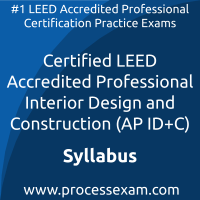 To achieve the professional designation of USGBC LEED Accredited Professional Interior Design and Construction from the USGBC, candidates must clear the AP ID+C Exam with the minimum cut-off score. For those who wish to pass the USGBC LEED Accredited Professional Interior Design and Construction certification exam with good percentage, please take a look at the following reference document detailing what should be included in USGBC LEED AP ID+C Exam preparation.
To achieve the professional designation of USGBC LEED Accredited Professional Interior Design and Construction from the USGBC, candidates must clear the AP ID+C Exam with the minimum cut-off score. For those who wish to pass the USGBC LEED Accredited Professional Interior Design and Construction certification exam with good percentage, please take a look at the following reference document detailing what should be included in USGBC LEED AP ID+C Exam preparation.
The USGBC AP ID+C Exam Summary, Sample Question Bank and Practice Exam provide the basis for the real Certified LEED Accredited Professional Interior Design and Construction (AP ID+C) exam. We have designed these resources to help you get ready to take USGBC LEED Accredited Professional Interior Design and Construction (AP ID+C) exam. If you have made the decision to become a certified professional, we suggest you take authorized training and prepare with our online premium USGBC LEED Accredited Professional Interior Design and Construction Practice Exam to achieve the best result.
USGBC AP ID+C Exam Summary:
| Exam Name | USGBC LEED Accredited Professional Interior Design and Construction |
| Exam Code | AP ID+C |
| Exam Fee |
Combined exam: $550 ($400 for USGBC members) Specialty only: $350 ($250 for USGBC members) |
| Exam Duration | 120 Minutes |
| Number of Questions | 100 |
| Passing Score | 170 out of 200 |
| Format | Multiple Choice Questions |
| Schedule Exam | USGBC |
| Sample Questions | USGBC LEED AP ID+C Exam Sample Questions and Answers |
| Practice Exam | Certified LEED Accredited Professional Interior Design and Construction (AP ID+C) Practice Test |
USGBC LEED Accredited Professional Interior Design and Construction Syllabus Topics:
| Topic | Details |
|---|---|
| LEED Process (11 Questions) |
- LEED interpretations
- LEED system synergies (e.g., energy and EQ; waste management) - Project boundary; LEED boundary; property boundary - Prerequisites and/or minimum program requirements for LEED certification - Differences between general ID+C rating system and the retail and hospitality subsets - Review process (back and forth with the reviewer) - LEED Online - Documentation compilation - Addenda and changes to the rating system (rating system development) - Existing building conditions - Ways to earn innovation credits:
|
| Integrative Strategies (8 Questions) |
- Integrative process (e.g., early analysis of the interrelationships among systems)
- Integrative project team (e.g., architect; engineer; landscape architect; civil engineer; contractor; facility manager, etc.) - Education of tenant/owner (e.g., development of a building manual; demonstration walkthrough of the green features in the building) |
| Location and Transportation (8 Questions) |
- Surrounding density and diverse uses (e.g., walkability; street design and intersection density)
- Access to quality transit (e.g., accessibility to multimodal transportation choices; quality transit; bicycle network) - Alternative transportation: infrastructure and design (e.g., parking capacity and design; bicycle storage and shower rooms) - LEED for neighborhood development location |
| Water Efficiency (10 Questions) |
- Indoor water use reduction
- Water performance management: types and quality of water (e.g., potable; nonpotable; alternative water sources)
|
| Energy and Atmosphere (15 Questions) |
- Energy use
- Energy efficiency: commissioning (e.g., commissioning authority [CxA]; owner’s project requirements [OPR]; basis of design [BOD]; monitoring-based commissioning; envelope commissioning; what is commissioning; who does commissioning; what is the difference between fundamental and enhanced commissioning)
- Alternative and renewable energy practices
- Energy performance management
- Environmental concerns: resource and ozone depletion (e.g., sources and energy resources [oil, coal and natural gas]; renewable and nonrenewable resources; chlorofluorocarbons [CFCs] and other refrigerants; stratospheric ozone layer)
- Modeling pathway, prescriptive vs. simulation - ASHRAE calculator - Lighting power density - ENERGY STAR equipment credit requirements |
| Materials and Resources (17 Questions) |
- Interiors life-cycle impact reduction
- Building product disclosure and optimization
- Waste
- Materials calculator
|
| Indoor Environmental Quality (16 Questions) |
- Indoor environmental quality
- Lighting: electric lighting quality (e.g., tradeoffs [color, efficiency]; surface reflectance; types of fixtures)
- Lighting control (e.g., multi-zone control systems; presentation controls) - Daylight (e.g., spatial daylight autonomy; annual sunlight exposure; glare; human health impacts; illuminance; measurement) - Acoustic performance (e.g., exterior and interior noise; background noise; dead vs. loud spaces; reverberation time; sound masking systems; sound transmission class) - Thermal comfort control - Thermal comfort design (e.g., ASHRAE 55) - Quality views (e.g., connection to outdoor environment; direct line of sight to outdoors; what makes a quality view; view factor) |
Both USGBC and veterans who’ve earned multiple certifications maintain that the best preparation for a USGBC AP ID+C professional certification exam is practical experience, hands-on training and practice exam. This is the most effective way to gain in-depth understanding of USGBC LEED AP ID+C concepts. When you understand techniques, it helps you retain USGBC LEED Accredited Professional Interior Design and Construction knowledge and recall that when needed.
